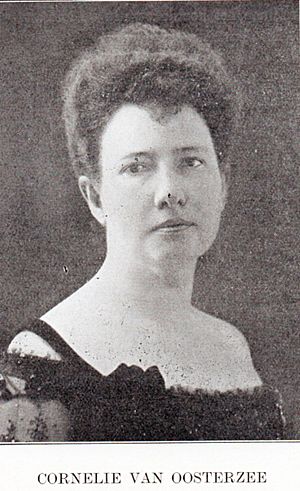Cornélie van Oosterzee facts for kids
Cornélie van Oosterzee (born August 16, 1863 – died August 12, 1943) was a talented Dutch pianist and composer. She wrote many different kinds of music, from operas to piano pieces.
Her Life Story
Cornélie van Oosterzee was born in Jakarta (which was called Batavia back then) on August 16, 1863. Her parents were Pieter Cornélis van Oosterzee and Johanna Theophanie Bernardina. She grew up with six brothers and sisters.
When Cornélie was five, her family moved from Jakarta to The Hague in the Netherlands. This is where her musical journey truly began. She started taking piano lessons with Carel Wirtz at the Royal Conservatoire The Hague. When she was 16, she began learning music theory from a famous composer and organist named Willem Nicolaï.
Her studies stopped in 1883 when her family moved back to the Dutch East Indies. Cornélie was very sad about this. She even wrote to the famous pianist Clara Schumann for advice about her future. Clara encouraged her to become a concert pianist.
After her mother passed away in 1888, Cornélie returned to the Netherlands. She continued her lessons with Nicolaï for a short time. Then, following advice from her friends Julius Rontgen and Johannes Masschaert, she moved to Berlin, Germany.
After two years in Berlin, she moved to Stuttgart to study with composers Samuel de Lange and Robert Radecke. Soon after, she returned to Berlin. She was accepted into Heinrich Urban's Master School for Instrumental Composers, which was a big achievement.
Cornélie van Oosterzee stayed in Berlin for the rest of her life. While there, she mostly wrote music for orchestras. Even though she lived in Germany, she was very well-known and respected in the Netherlands. In 1897, she was made a Knight of the Order of Oranje-Nassau. This is a special honor given by the Dutch royal family.
She also composed and conducted a special song (called a cantata) for the opening of the Nationale Tentoonstelling van Vrouwenarbeid (National Exhibition of Women's Labor) in The Hague in 1891. We don't know much about the very end of Cornélie's life. She lived with her sister in Berlin until she passed away in 1943.
Sadly, many of her musical pieces were lost during the Battle of Berlin in World War II. About 40 of her works have been saved and are still known today.
Her Music
Cornélie van Oosterzee's music was influenced by composers like Wagner and Strauss. She wrote in a style called "late romantic," which means her music was often very emotional and dramatic. She composed many different types of music, including:
- Songs for choirs
- Songs for solo singers
- Music for piano
- Music for small groups of instruments (chamber music)
- An opera
- Various pieces for orchestras
One of her works, Sechs leichte Klavierstucke op.55 (Six Easy Piano Pieces), is special because it mentions her time in Indonesia. It includes a Malaiisches Wiegenliedchen (Malay Lullaby) and a Javanische Tanz (Javanese Dance).
Here are some of her well-known works:
- Das Gelöbnis (The Promise) – an opera from 1910
- Koningsidyllen (King's Idylls) – a symphonic poem based on poems by Tennyson
- Nordische Phantasy (Nordic Fantasy)
- Prelude to Iolanthe
- Te Bethlehem (In Bethlehem) – from 1895
- Chansons Sentimentales op.54 (Sentimental Songs) – from 1905
- Symphony in F minor
- Cantata for the opening of the National Exhibition for Women's Labor in 1898


